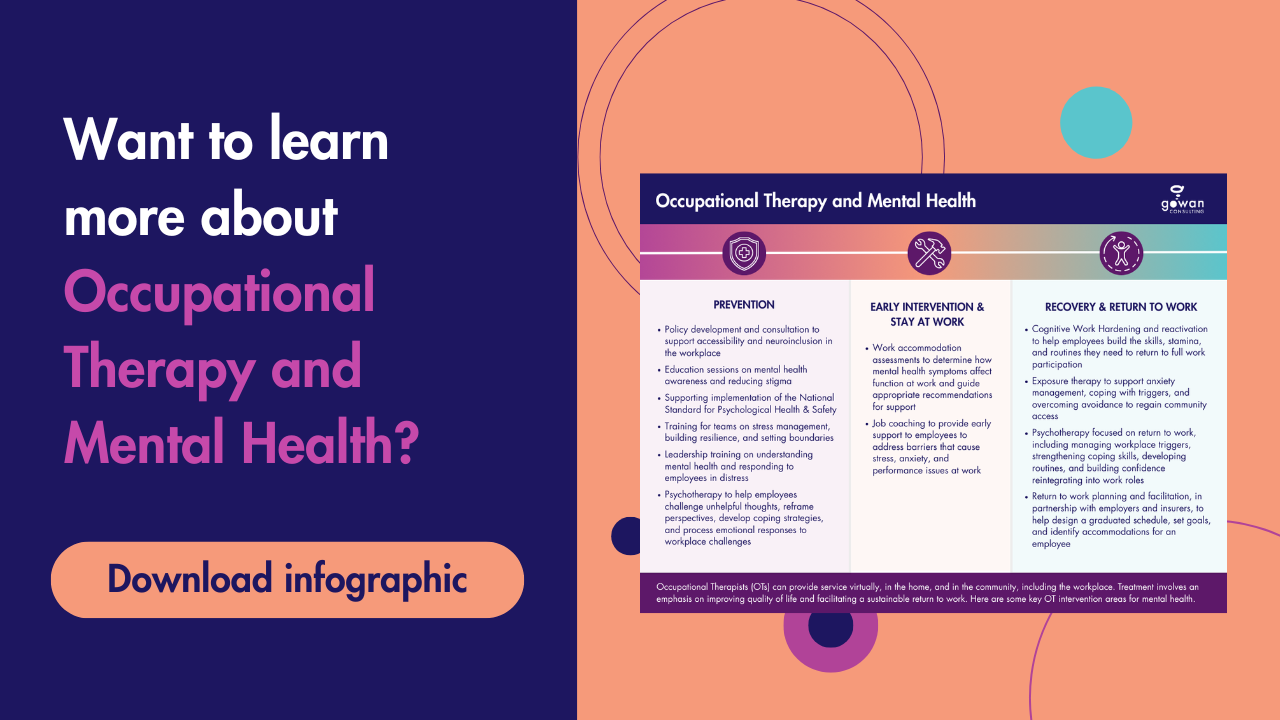Best Practices for Addressing Mental Health in the Workplace
Oct 16, 2025
Mental health exists on a continuum. Any individual can move between thriving, struggling, and being in crisis based on workplace demands, life stressors, and support systems. Recognizing where someone might be on that mental health continuum can help leaders know the right supports to provide at the right time.
Across Canada, the need for workplace mental health support has never been greater. Mental health-related disability claims now account for 70% of workplace disability, and 80% of employees on long-term leave cite job demands or the work environment as primary contributors to poor mental health.1
These numbers reflect what many organizations are already seeing: a significant rise in mental health-related absences, with more employees experiencing burnout, anxiety, and depression. For many, these challenges are not short-term; they are complex and persistent, affecting both personal wellbeing and workplace performance.
As mental health conditions become more complex, organizations need practical, evidence-based strategies to respond effectively. A full mental health toolbox includes strategies for building psychological safety, intervening early, and supporting recovery.
Thriving and Coping Well: Prevention and Accessibility
What Employers Might See:
Employees are engaged, collaborative, and adaptable. They communicate openly, meet expectations, and maintain work-life balance. However, even thriving employees need the right environment to stay well. Changes in life events or an unhealthy workplace can push employees from a “healthy” range further down the continuum. Employers have a large impact on employee mental health, so it’s important to recognize their role in preventing harm at work.
Goal: Prevent distress, maintain inclusion, and create an environment where employees can perform their best.
Strategies for Employers:
- Build Psychologically Safe Workplaces: Encourage solution-focused communication where employees can discuss challenges or mistakes without fear of blame.
- Promote Accessibility and Neuroinclusion: Review policies and procedures to ensure they accommodate diverse learning, communication, and sensory needs. Embed flexibility and inclusivity into job design.
- Address Stigma Before It Starts: Normalize mental health discussions during team meetings or performance conversations. Emphasize that mental health, like physical health, fluctuates.
- Support Leader Wellbeing: Leaders influence team culture and resilience. Provide leadership coaching, mental health training, and resources to build confidence and empathy.
- Train Managers Early: New leaders often lack the skills to identify or address early signs of distress. Training, such as Manager Mental Health Training, builds awareness and empowers them to act appropriately when employees’ mental health declines.
Showing Early Signs of Distress: Early Intervention and Stay-at-Work Support
What Employers Might See:
Employees may appear fatigued, distracted, withdrawn, or anxious. Work quality or attendance may fluctuate. They might be overwhelmed by workload or struggling to focus. These changes often indicate that an employee is moving into the “reacting” or “struggling” zone of the continuum.
Goal: Prevent escalation, maintain engagement, and keep employees successfully at work through supportive, flexible approaches.
Strategies for Employers:
- Recognize and Respond Early: Train managers to identify subtle changes in behavior, communication, or performance. Approach conversations with curiosity and empathy rather than assumptions. Example question: “What tasks are feeling most challenging right now?”
- Offer Function-Focused Support: Focus on what’s needed for the employee to perform effectively — not on medical details or diagnoses. Ask, “What would help you do your best work?”
- Implement Adjustments or Accommodations: Address the functional impacts of mental health challenges, which are often cognitive in nature (executive functioning, communication, sensory processing, memory, and concentration). Strategies may include gradually adjusting workload or cognitive demands, providing structured supports such as checklists or additional training time, and modifying the work environment with quiet spaces or reduced meetings.
- Encourage Access to Resources: Remind employees of EAPs, benefits, and community mental health resources. Early referral to Occupational Therapy (OT) for an accommodation assessment can help assess functional challenges and provide tailored strategies to stay at work.
- Support Managers Too: Provide ongoing training so they understand their role in accommodation, know when to refer to specialists, and have the tools to maintain their own wellbeing.
In Crisis or Experiencing Significant Mental Health Challenges: Recovery and Return to Work
What Employers Might See:
Employees may be on leave or experiencing significant difficulty functioning at work. They may appear highly anxious, disengaged, or unable to sustain performance. At this stage, the focus shifts to recovery and sustainable reintegration.
Goal: Facilitate a safe, person-centered recovery that restores confidence, builds resilience, and supports long-term success at work.
Strategies for Employers:
- Coordinate Support Collaboratively: Engage HR, managers, healthcare providers, and the employee in return-to-work planning. Everyone has a role — no one should navigate this alone.
- Create Function-Based Return-to-Work Plans: Focus on what the employee can do. Avoid medical labels; instead, identify tasks and work conditions that support success.
- Implement a Graduated Return: Gradually increase hours or workload intensity while providing built-in opportunities for success.
- Use OT Psychotherapy: OTs use exposure, reactivation into regular routines, and work-focused CBT to support employees who are off work due to chronic mental stress or fear of returning to work. Psychotherapy desensitizes anxiety, rebuilds confidence, builds resiliency, and prevents overwhelm/risk of setback.
- Maintain Connection During Leave: Regular, respectful contact helps employees feel valued and reduces anxiety about returning.
- Reassess and Adjust Accommodations: As employees recover, revisit accommodations to ensure they remain effective and sustainable.
[1] CSA Public Policy Centre, Navigating the Mental Health Crisis in Canada: The Critical Role of Employers.


